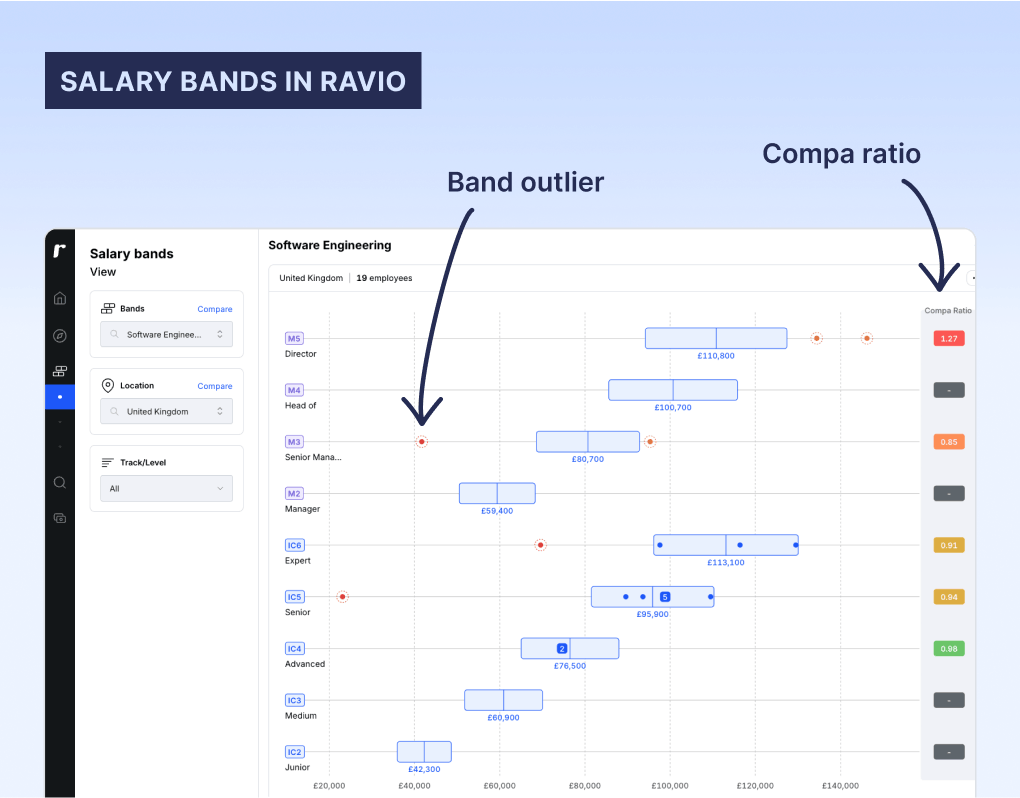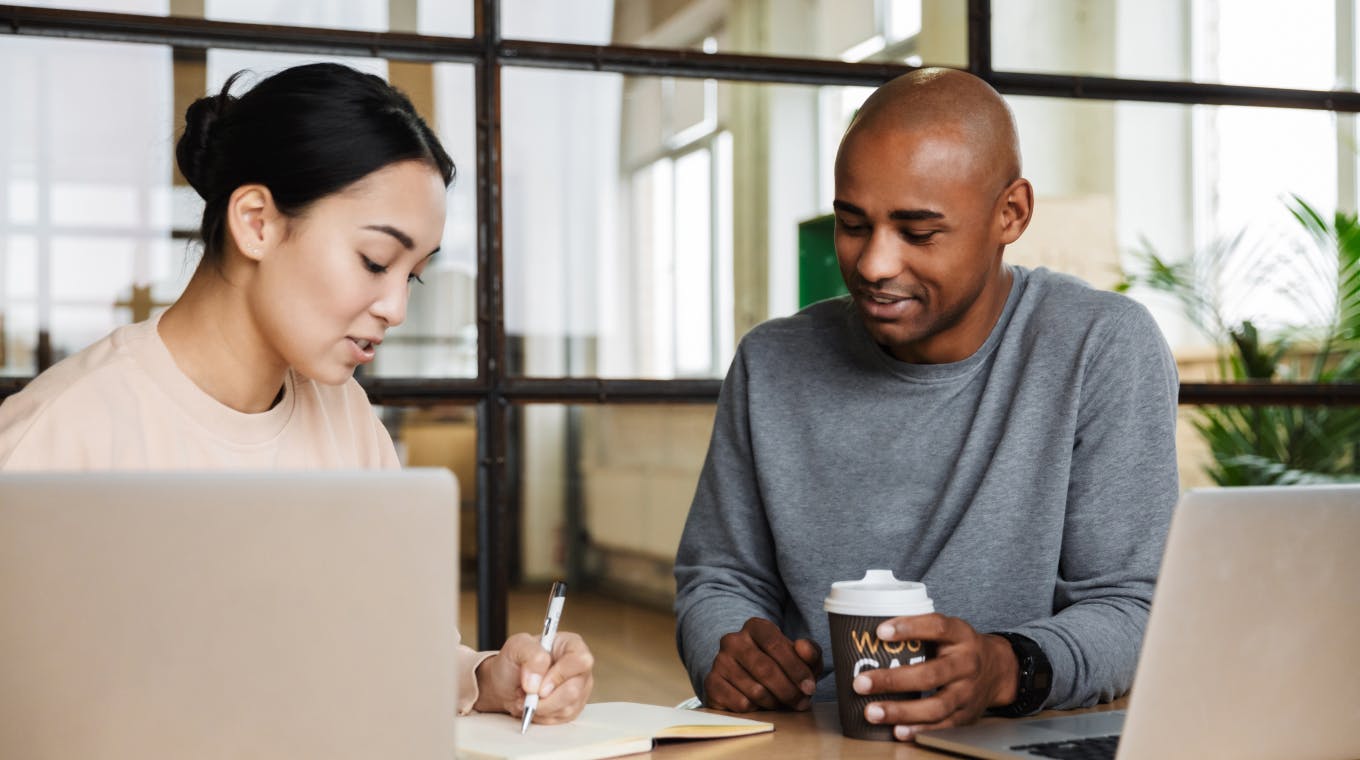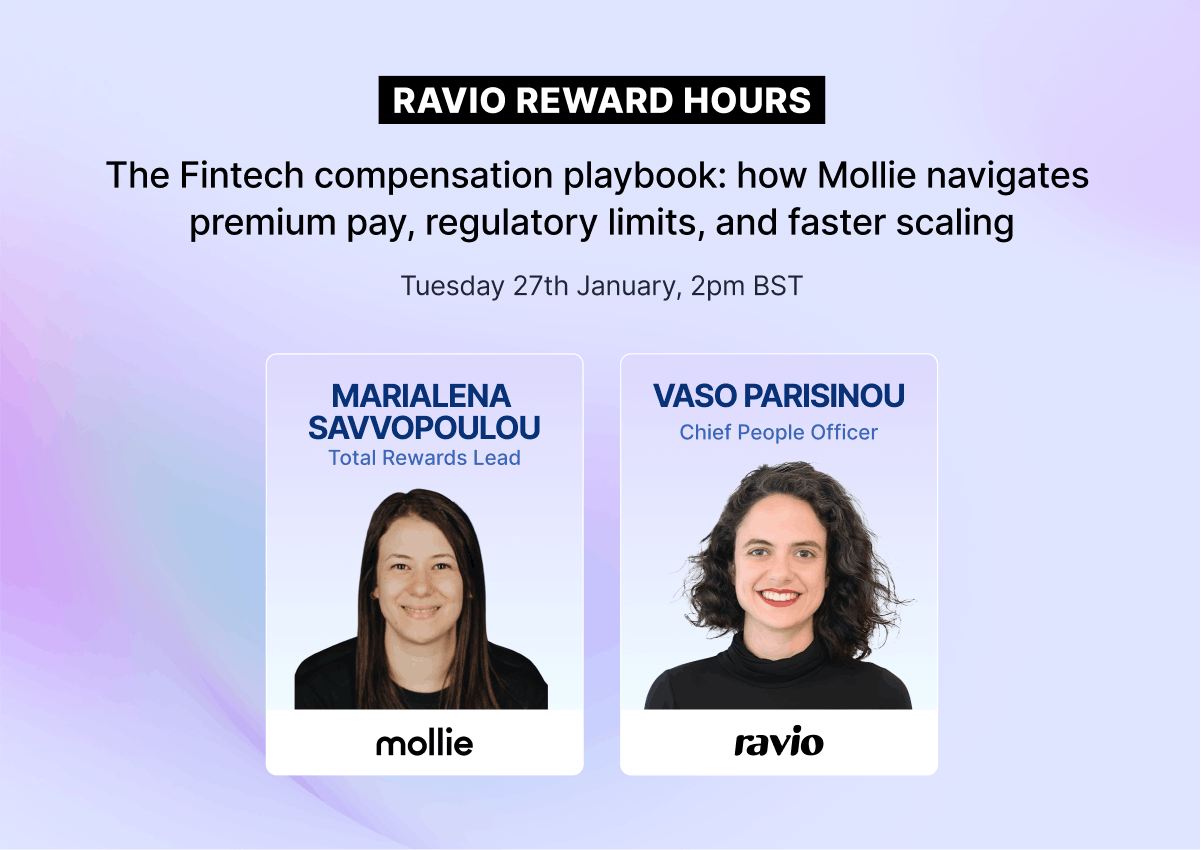Pay progression refers to how an employee’s salary (as well as other components like equity and variable pay if applicable) increases within their current role and salary band – as they build up experience, skills, and impact over time.
It’s important to keep track of, because pay progression and career progression are vital aspects in employee engagement, motivation, and retention.
When employees know they are able to develop, grow, and increase their salary within a company, they’re way more likely to stick around.
Pay progression is typically measured using either compa ratio or salary range penetration as the key metric – in this article we’ll take a closer look at both of these options.
Here’s what we’ll cover:
- Part 1: What does typical employee pay progression look like?
- Part 2: How to calculate compa ratio
- Part 3: How to calculate salary range penetration
- Part 4: Worked example: using the compa ratio and salary range penetration to calculate employee pay progression
🧮 Free calculator: compa ratio and salary range progression
We’ve put together a simple tool for calculating employee pay progression using either the compa ratio or salary range penetration.
What does typical employee pay progression look like?
Employee pay progression within their salary band varies from company to company, depending on the career progression framework and compensation structure.
The typical approach is for salary bands to have a range or width (minimum to maximum salary for that role) which is around 15% either side of the midpoint.

The employee will progress from their starting salary through that salary range with incremental pay increases as they hit key milestones for their role in terms of tenure, experience, skills, impact, responsibility, etc – edging towards a promotion to the next job level and salary band.
This standard width of 15% either side of the midpoint reflects expected career progression of around:
- 5-10% annual salary increase
- 3-4 years within the role before being promoted to the next level.
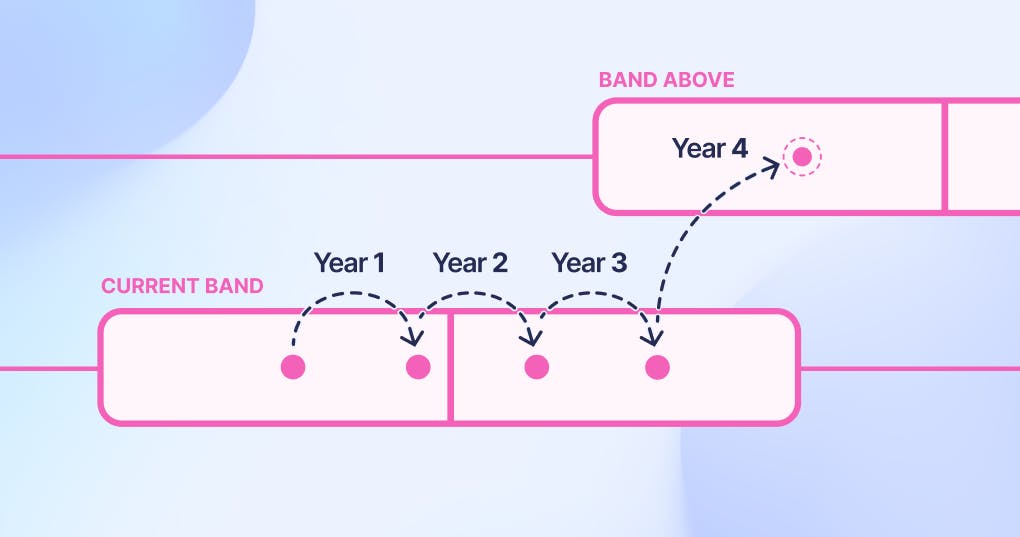
It’s important to note that it’s highly unusual for an employee to start out at the very minimum of their band or end up at the very maximum of the band. These reflect the absolute minimum and maximum that an employee in this role can be paid, before they are identified as a salary band outlier and there is concern about their pay.
Within this ‘standard’ there is, of course, variance.
For example, the time to promotion is usually much shorter in the early stages of a career as employees develop skills and experience much more quickly. In the later stages of a career it’s typical for employees to stay within one job level (and salary band) for many years, progressing more slowly with smaller pay increases.
Equally, in a company using a pay for performance model, a high-performing employee is likely to receive higher pay increases or a promotion to the next job level and salary band more quickly than their colleagues.
Exploring different scenarios for pay progression through salary bands for your employees in this way is a useful activity when:
- Building (or improving) the overall salary band structure: to model different progression pathways, aiming to ensure that employees are able to grow within the company and that their compensation will progress smoothly as that happens.
- Building a salary offer for a new hire: to understand how the candidate will be able to progress their pay within the role, and share this information with the candidate to build their confidence in the career growth potential of the role.
- Implementing transparent bands: to enable employees to understand how the salary band structure is set up, and how it supports their own career and salary goals.
The two key metrics for measuring and modelling pay progression are the compa ratio and salary range penetration – let’s take a closer look.
How to calculate compa ratio
Compa ratio is the most common calculation used to understand employee pay progression within their salary band.
What is compa ratio?
Compa ratio measures how an employee’s current salary compares to the midpoint of the salary band for their role.
How is compa ratio calculated?
The compa ratio is calculated by taking an employee’s current salary and dividing it by the midpoint of the salary band for their role, with the calculation:
Compa ratio = actual salary ÷ salary band midpoint.
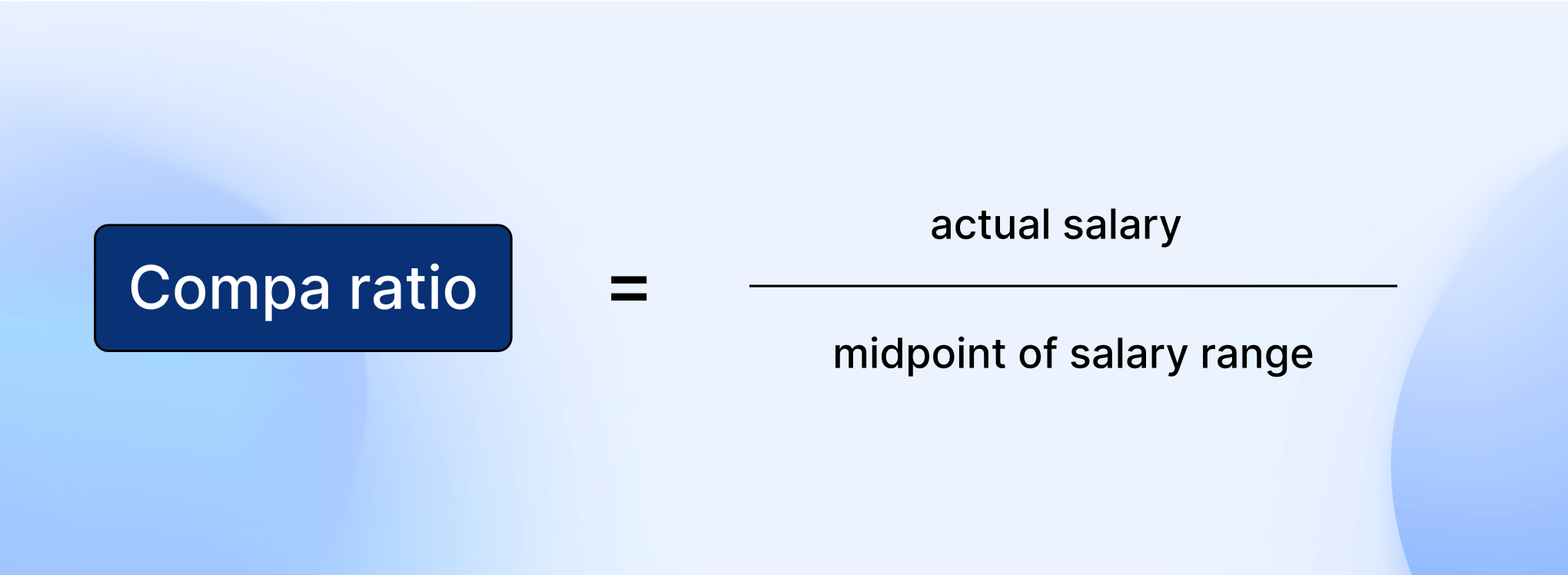
If the resulting ratio is 1.0, the salary is exactly at the midpoint of the range. Anything less than 1.0 means the salary is below the salary midpoint, and above 1.0 means it is above.
🛠️ Free tool: Compa ratio calculator
This might be a relatively simple calculation, but it can become a long process when you’re calculating the compa ratio for hundreds of employees.
To make it easier, we’ve set up a simple compa ratio calculator that you can use to understand employee pay progression or model different future scenarios.
How do HR teams use the compa ratio?
The compa ratio is particularly useful for measuring the fairness of compensation structures and monitoring internal pay equity.
In a best practice salary band structure, the salary band midpoint is the same as the target percentile agreed within the company’s compensation philosophy.
For instance, if the company is targeting the market median or 50th percentile, then the midpoint of each salary band should reflect the 50th percentile for the role, level, and location that the band covers.

Therefore, the compa ratio is an easy way to understand whether employees are being under or overpaid against the compensation philosophy – though this must also be contextualised with the employee’s tenure, experience, and performance level too.
In terms of internal pay equity, this is a useful metric for understanding whether different groups of employees are being compensated fairly.
During a gender pay analysis a company might identify that women systematically have lower compa ratios than male employees who are performing equal work or work of equal value to those women – which is a clear indicator of a systematic gender pay equity issue.
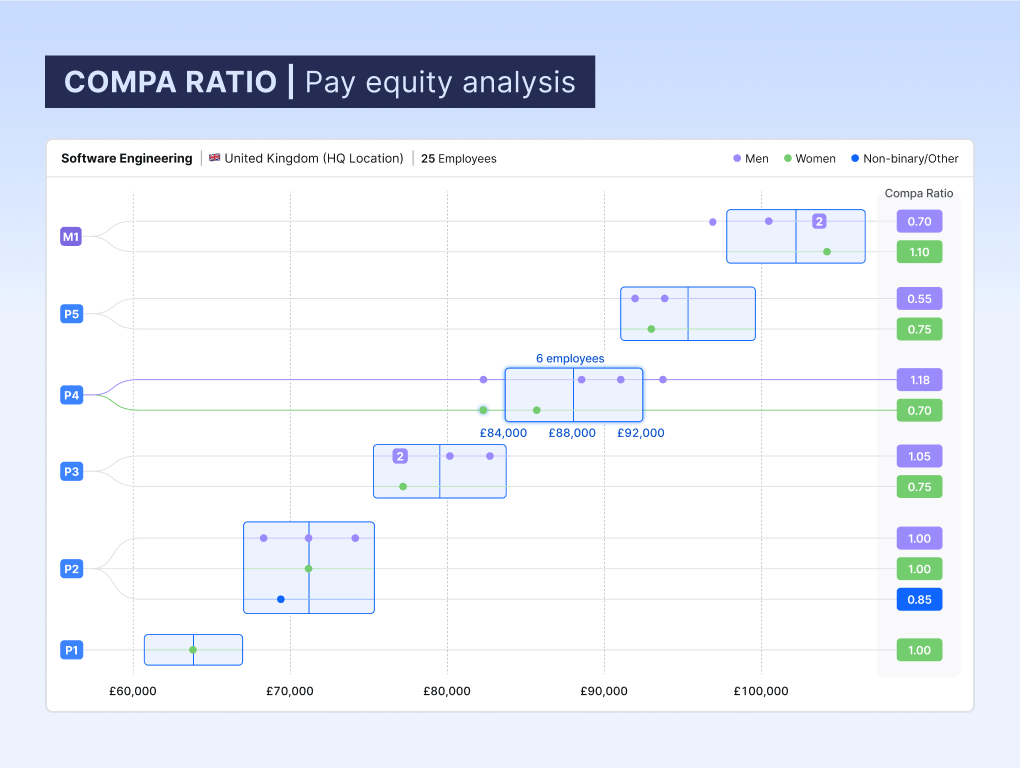
For instance, in this example set of salary bands for UK Software Engineering we can see that the compa ratio for women in P3 and P4 is a fair amount lower than for men – which could be worth investigating.
Further, because the compa ratio compares employee pay to the band midpoint, it’s also a useful metric for understanding market competitiveness during a compensation review too.
One of the first steps in any best practice compensation review process is to refresh the underlying salary benchmarking data that is used to inform the salary band midpoint – for the company targeting the market median, they will have used benchmarking data to understand what the market median is for each salary band in their structure.
Once the salary bands are refreshed, the compa ratio can then be used to see how employees compare to the new market normal.
It might be the case that typical salaries for a particular role, department, or location have shifted significantly since the salary bands were last refreshed – in which case you’ll notice that the compa ratio for many individual employees has dropped.
This is a clear indication that market adjustments are needed during the compensation review to ensure that the salaries of these employees are brought back in line with the market, to avoid attrition issues.
Many companies use a merit matrix to combine the compa ratio with employee performance ratings during compensation review, to determine the salary increase that each employee should receive.

How to calculate salary range penetration
Salary range penetration is a measure used to understand the position of an employee’s current salary within their whole salary band i.e. how far through the band their salary is, expressed as a percentage.
How is salary range penetration calculated?
Salary range penetration is calculated using the minimum and maximum points of the employees salary band, with the following formula:
Salary range penetration = (actual salary - minimum salary) ÷ (maximum salary - minimum salary)
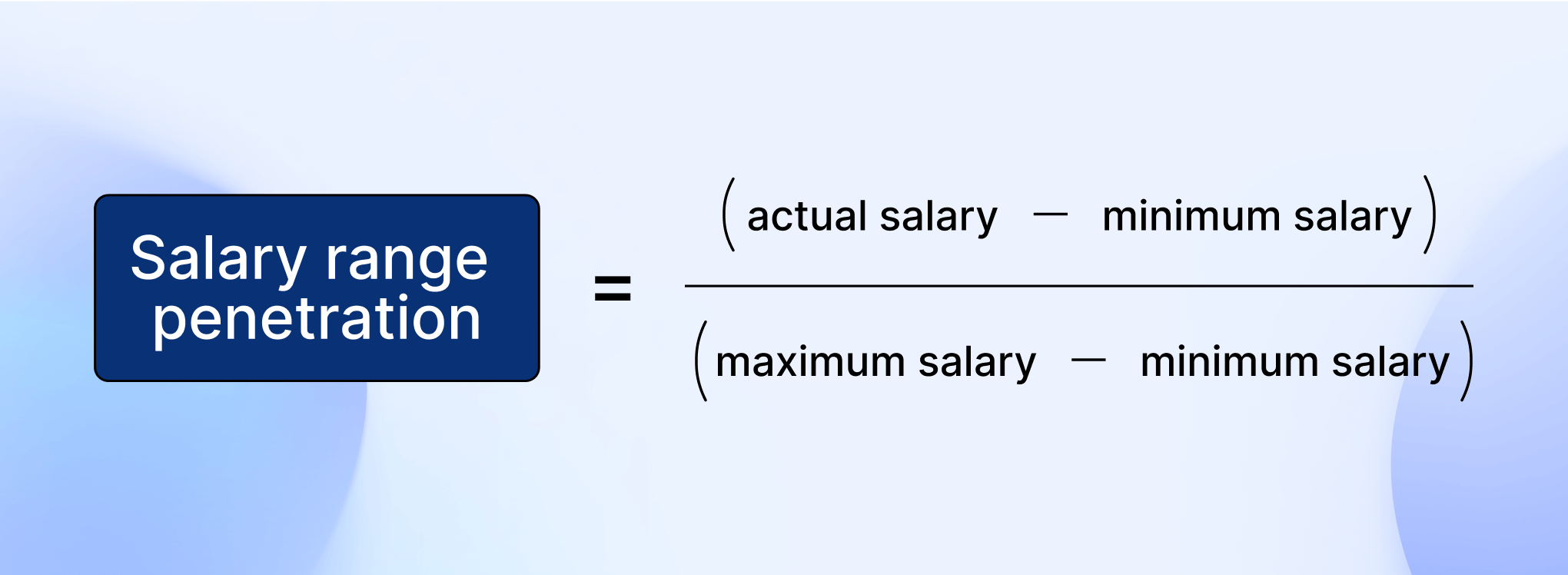
🛠️ Free tool: Salary range penetration calculator
Working out the salary range penetration for every employee in an organisation can quickly become a lengthy task that’s prone to error.
To make it easier, we’ve set up a simple salary range penetration calculator that you can use to understand employee pay progression or model different future scenarios.
Go to the salary range penetration calculator

Salary range penetration vs compa ratio: which should you use?
Both salary range penetration and compa ratio are used to assess an employee’s salary within their salary band, and to monitor pay progression over time.
The key difference is that whilst compa ratio compares to the midpoint of the range, salary range penetration looks at the whole range – which can be more helpful for employees who sit in the lower or upper quartiles of the band.
Salary range penetration can also be a more intuitive metric to use when communicating about compensation with line managers and employees – it’s a simple formula to grasp, and doesn’t need an understanding of how market benchmarks and midpoints work.
However, compa ratio is the most commonly used metric because it enables a closer analysis of employee salary compared to market benchmarks and a company’s compensation philosophy.
Worked example: using the compa ratio and salary range penetration to calculate employee pay progression
Let’s say we have a salary band for a role which ranges from £42,500 to £57,500 – that’s the standard 15% width either side of a midpoint of £50,000.

An employee is hired into the role with a starting salary of £48,500.
By calculating the compa ratio and salary range penetration we can quickly get a picture of how this starting salary sits within the overall salary band.
In this case, the compa ratio is £48,500 / £50,000 = 0.97. So the employee’s starting salary puts them slightly below the midpoint of their band.
The salary range penetration is (£48,500 - £42,500) ÷ (£57,500 - £42,500) = 0.4 or 40% through the entire salary band.
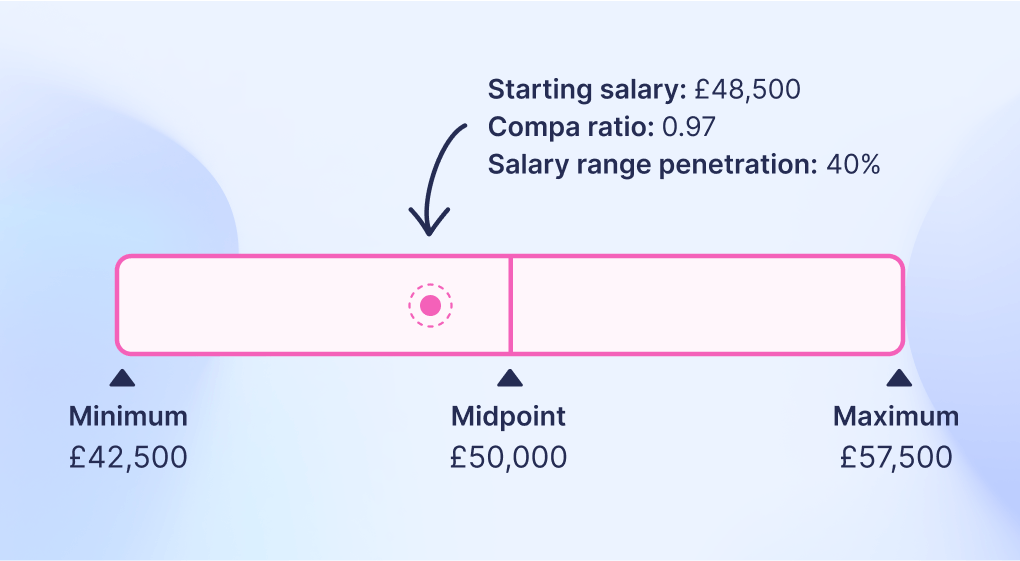
The employee receives an average annual salary increase of 5% throughout their time in this role, and so moves through the salary band in small yearly increments – increasing their compa ratio each time.
After three years in the role, the employee is promoted to the next level and salary band.
So, the employee’s pay progression within the initial role looks like this:
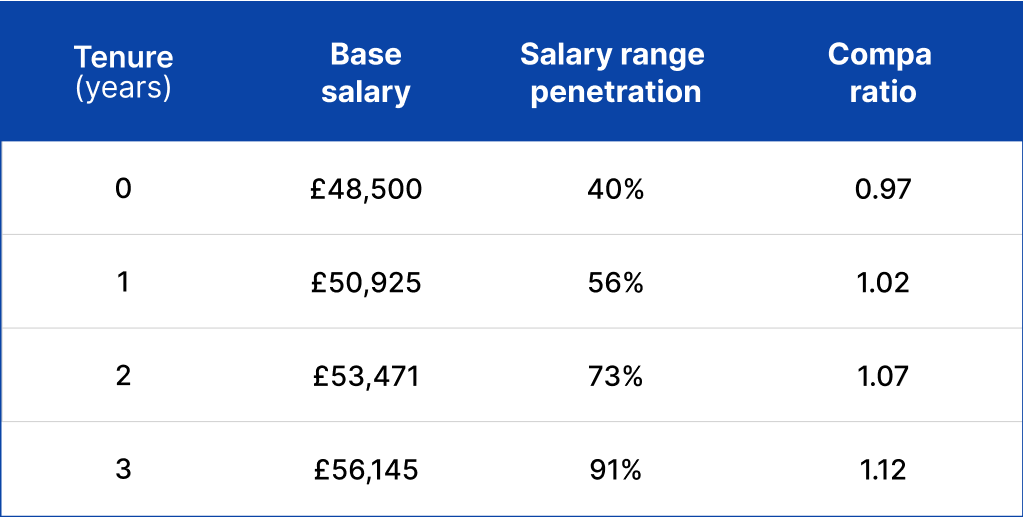
Salary band software like Ravio’s makes this even easier to measure and monitor over time – automatically calculating the compa ratio for each employee, as well as for the salary band as a whole, so that you can quickly understand pay progression within the band structure.
Salary band outliers are also automatically shown within Ravio salary bands, highlighting where pay progression may be occurring too slowly or too quickly for certain employees, damaging pay equity.
